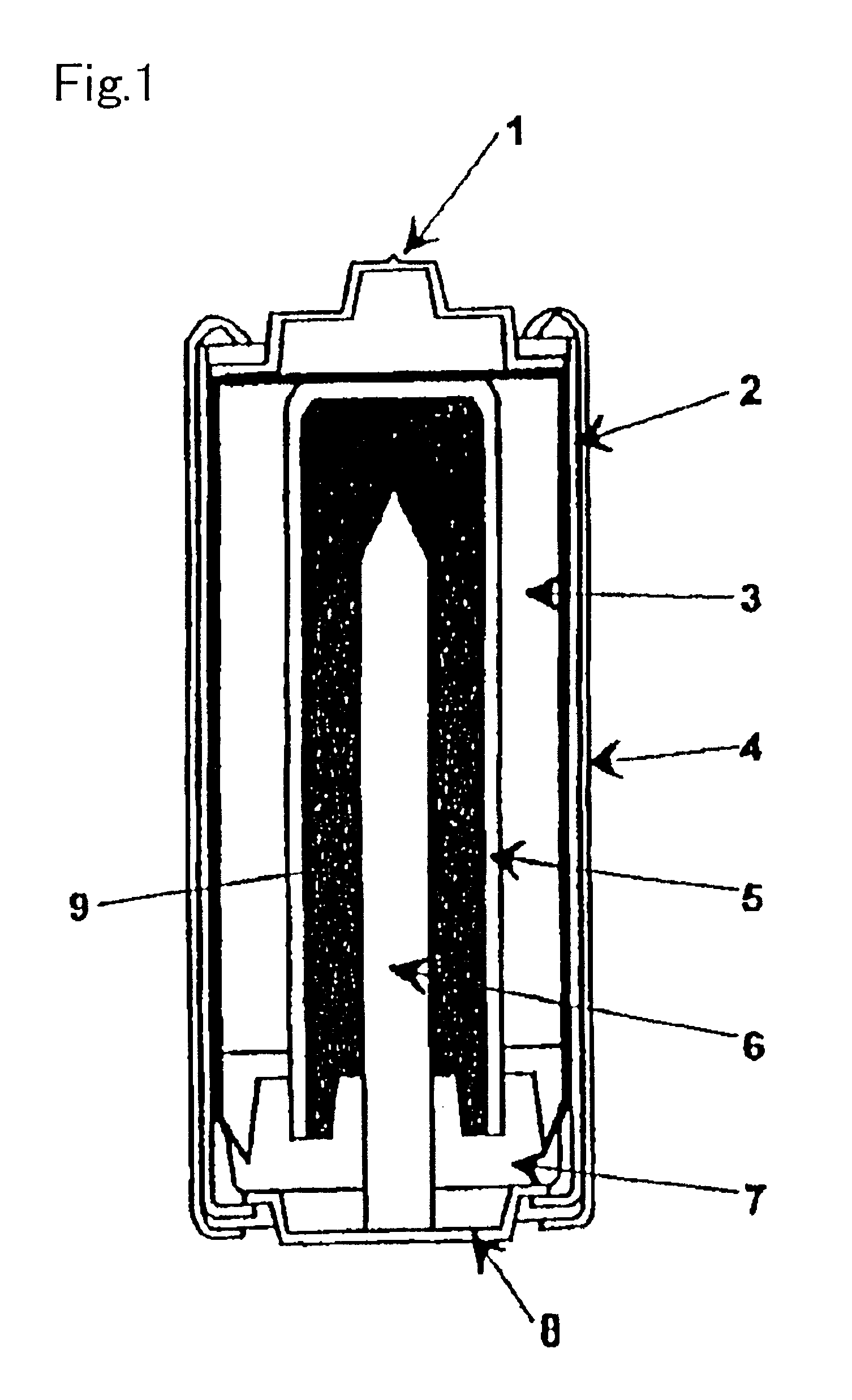However, these gelating agents are not necessarily satisfactory in prevention of
precipitation of a zinc powder, liquid leakage from a cell, and drain of gelating agents, in productivity of cells, and the like.
In the case (
meth)
acrylic acid is neutralized based on necessity, generally an
alkali metal hydroxide such as
potassium hydroxide,
sodium hydroxide,
lithium hydroxide, and the like or their aqueous solutions may be added to (meth)
acrylic acid in
monomer stage before
polymerization or to a water-containing gel after
polymerization, however, in the case of using an allyl
ether type copolymerizable cross-linking agent (b), which will be described later, the agent is insufficient in water-
solubility, so that if polymerization is carried out in high
neutralization degree of (meth)acrylic acid, it is sometimes impossible to obtain the cross-linked
polymer (A) with defined physical properties even with addition of a prescribed amount of the cross-linking agent (b) attributed to isolation of the cross-linking agent (b) from the aqueous
monomer solution and impossibility of the prescribed cross-linking reaction.
However, the
polymer produced by the
precipitation polymerization or the
emulsion polymerization generally becomes finely granular and they are impossible to provide an aiming polymer to be a gel with a
large particle size necessary to prevent the precipitation of a zinc powder in an aqueous alkaline solution.
Even if the particle
diameter of a dried polymer produced by the
precipitation polymerization method or the
emulsion polymerization method followed by
granulation is enlarged, the strength in the junction parts becomes weak and thus most of the granulated polymer is broken down to a
fine powder state as it is before when it is mechanically stirred in an aqueous alkaline solution, so that these methods are not suitable for the method for producing the gel with a
large particle size in an aqueous alkaline solution.
Regarding
bulk polymerization, if the polymerization is carried out with approximately 100% of the monomer concentration, an immense quantity of polymerization heat is generated to make polymerization
temperature control extremely difficult and consequently it is made difficult to obtain a polymer with a high molecular weight and to produce a large amount of oligomers.
Further, just like a
bulk polymerization, if (meth)acrylic acid (
alkali metal salts) are polymerized in a
high concentration, kind of pseudo-cross-linking reaction, so-called self-cross-linking, is promoted in parallel to the polymerization owing to the characteristics of the monomers to make it extremely difficult to control the cross-linking degree and production of a desired gelating agent of the present invention becomes difficult.
As another
drying method for a water-containing gel in the
aqueous solution polymerization, there disclosed in Japanese Patent No. 8-28216 is a contact-
drying method comprising steps of contracting and extending the water-containing gel on a drum drier and
drying the gel, however since the water-containing gel is inferior in the
thermal conductivity, a thin film of the water-containing gel has to be formed on the drum for the drying.
Further, since the contacting frequency between the foregoing water-containing gel and the drum is extremely high and the foregoing water-containing gel has high
viscosity, it is required for the dried product to be peeled from the drum drier by bringing a knife-like tool into contact with the drum drier and owing to the
mechanical abrasion of the drum and the knife-like tool, the
metal faces of the drum and the knife-like tool are worn out and the dried product is contaminated with the metals.
As described above, in the case the contact drying method is employed using the drum drier, the gelating agent is easily be contaminated with
metal ions and
metal powders and if a gelating agent containing a rather large amount of ions and powders of these metals with a lower
ionization tendency than zinc (metals with a lower normal
electrode potential than zinc and including metals having atomic symbols of Cr, Fe, Ni, Sn, Pb, Cu, Hg, Ag and the like) is used as the gelating agent for an alkaline cell, cells are formed between the zinc powder and the contaminating metal ions in the cell and
hydrogen gas is evolved by the
electrolysis to increase the
internal pressure of the cell and cause leakage of the alkaline solution and in some extreme cases, the cell is broken and therefore the drying method is not preferable.
Further, the thin film-like dried product obtained by contracting and extending the water-containing gel on the drum drier and drying the gel is made to be a flaky particle even if the dried product is pulverized thereafter and adjusted as to have a desired particle size, so that the strength of the dried product is considerably inferior in the strength as compared with that of a pulverized product of a block-like product dried by the
permeation drying method or the ventilation drying method and in the case the obtained powder is swollen in an aqueous alkaline solution with a high concentration and then mechanically stirred and mixed with a zinc powder, the swollen gel is broken to be small and thus the drying method is not preferable.
If the drying temperature is 150.degree. C. or higher, the polymer is sometimes cross-linked by the heat at the time of drying to lower the absorption amount and the
viscosity and on the other hand, if drying at 50.degree. C. or lower, the drying takes a long time and is not efficient.
However, even if
iron removal is rather finely carried out using the iron removing apparatus, it is difficult to remove non-magnetic metals by the iron removing apparatus and further even magnetic metals, those contained in the dried
polymer particle and adhering to the dried particle cannot be removed and therefore it is desirable to pay careful consideration to the production facilities so as to avoid
contamination of these metals from the beginning.
 Login to View More
Login to View More  Login to View More
Login to View More 
